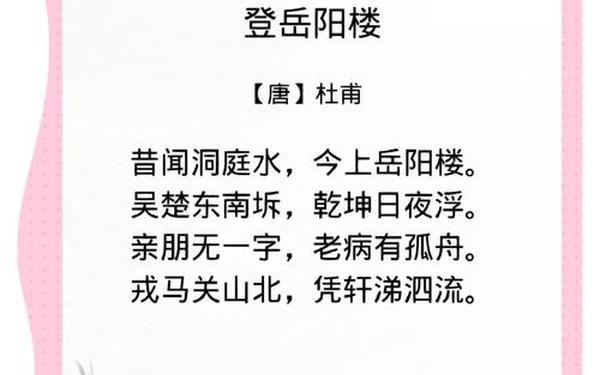杜甫的《登岳阳楼》是唐代五言律诗的代表作之一,通过壮阔的洞庭湖景象与个人漂泊、家国忧思的结合,展现了诗人深沉的现实主义情怀。以下是该诗的原文、白话翻译及不同版本的英文翻译:
原文
昔闻洞庭水,今上岳阳楼。
吴楚东南坼,乾坤日夜浮。
亲朋无一字,老病有孤舟。
戎马关山北,凭轩涕泗流。
白话翻译
译文一(综合网页1、13、18):
早年便听闻洞庭湖的浩瀚,如今终于登上岳阳楼。
吴楚之地被湖水分隔东南,天地似在湖面昼夜沉浮。
亲朋杳无音信,我年老多病,唯有孤舟相伴。
北方战火未息,倚栏远望,不禁涕泪横流。
译文二(网页2、12):
久闻洞庭湖盛名,今日终得登楼远眺。
湖水割裂吴楚东南,日月星辰在波涛中浮荡。
漂泊中亲友无音讯,老病缠身,独居孤舟。
北疆战事频仍,凭窗北望,忧国之泪难抑。
英文翻译
版本一(Burton Watson译,网页24、34、50):
Climbing Yueyang Tower
Long ago I heard of Lake Dongting,
Now I climb Yueyang Tower:
Wu and Chu slope off to south and east,
Heaven and Earth day and night float on these waters.
Of kinfolk, friends, not one word,
Old, sickly, in my solitary boat,
And north of the barrier mountains the fighting goes on—
As I lean on the railing, tears stream down.
版本二(许渊冲译,网页50):
On Yueyang Tower
Long have I heard of Dongting Lake,
Now I ascend the Yueyang Height.
Here eastern state and southern break;
Here sun and moon float day and night.
No word from friends or kinsfolk dear,
A boat bears my declining years.
War’s raging on the northern frontier,
Leaning on rails, I shed sad tears.
版本三(赵彦春译,网页39):
Climbing Yüehshine Tower

I heard of Cavehall long ago;
Today I climb up Yüehshine Tower.
Wu and Ch’u split in the southeast;
Heaven and Earth float hour by hour.
From my kin and friends not a word;
In my lone boat, old age and ail.
War-horses north of barrier hills,
Tears streaming, I lean on the rail.
翻译特点分析
1. 意象处理:
2. 情感传递:
3. 押韵与节奏:
许渊冲的译文注重押韵(如“Height”与“night”,“frontier”与“tears”),更具诗歌韵律;而Burton Watson的版本更贴近原文字面意义。
文化背景补充
此诗创作于杜甫晚年(768年),时值安史之乱后,诗人漂泊至岳阳,登楼北望战火未息的北方,将个人命运与国家兴亡交织,形成“沉郁顿挫”的独特风格(网页1、13、18)。诗中“乾坤日夜浮”不仅是自然景象的描绘,更隐喻了动荡时局中个体与家国的浮沉。
如需进一步了解杜甫生平或诗歌赏析,可参考相关古籍或研究文献。

